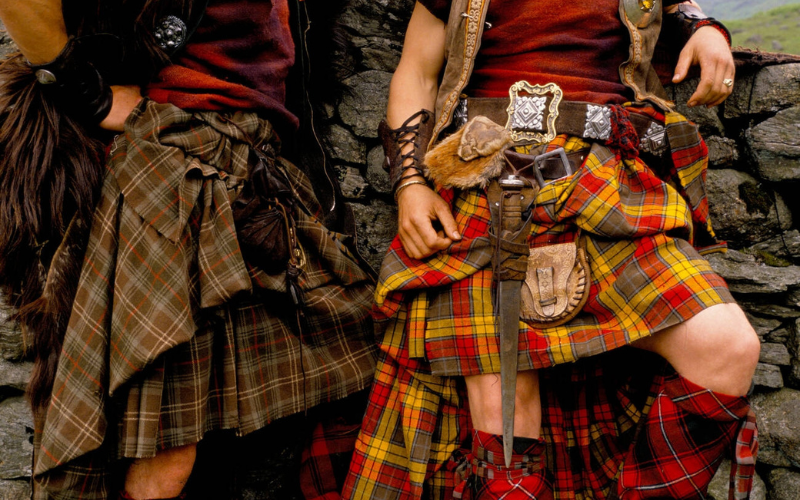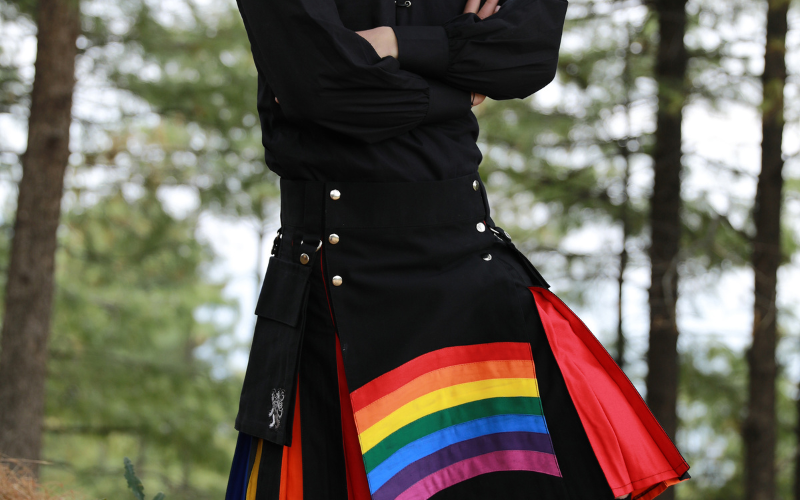In a world where fashion often transcends mere clothing and becomes a canvas for self-expression, the rainbow kilt emerges as a vibrant tapestry of identity and culture. Beyond its aesthetic appeal, the rainbow kilt carries a profound symbolism, weaving a story of diversity, acceptance, and personal narrative. In this exploration, we will delve into the layers of meaning behind the rainbow kilt, uncovering its rich symbolism as a colorful expression of identity.
Colors as Language:
At the heart of the rainbow kilt’s symbolism lies a spectrum of colors, each representing facets of identity and heritage. Red symbolizes courage; orange, warmth, and community; yellow, joy and positivity; green, growth and harmony; blue, peace and tranquility; indigo, intuition and introspection; violet, creativity and spirituality. Together, these hues form a language that speaks volumes about the wearer’s individuality and cultural roots.
Cultural Significance:
The cultural significance of the rainbow kilt is profound, serving as a powerful emblem that transcends geographical and cultural boundaries. Rooted in the rich tapestry of human experiences, the rainbow kilt becomes a visual representation of diversity and inclusivity. In various cultures around the world, the use of color in clothing has long been a means of expressing identity, beliefs, and affiliations. The rainbow kilt, with its amalgamation of vibrant hues, encapsulates the essence of this tradition. It is often worn during ceremonies, weddings, festivals, and LGBTQ+ pride events, symbolizing a celebration of shared identity and collective unity. The kilt becomes a canvas for personal expression, allowing individuals to select colors that resonate with their unique stories and experiences. Through the lens of cultural significance, the rainbow kilt not only honors historical practices but also becomes a contemporary symbol of acceptance and pride, fostering a sense of belonging in a diverse world.

Personal Expression:
Beyond its cultural connotations, the rainbow kilt becomes a canvas for personal expression. Individuals select colors that resonate with their stories, experiences, and aspirations. Whether a bold combination reflecting strength and resilience or a softer palette expressing introspection and creativity, the rainbow kilt transforms into a unique form of self-expression.
Rituals and Ceremonies:
The role of the rainbow kilt in rituals and ceremonies is deeply embedded in its symbolic significance and vibrant colors. During weddings, the rainbow kilt takes on a special meaning, with couples incorporating its diverse colors into their attire to symbolize the merging of their identities into a harmonious union. This colorful expression becomes a visual representation of the couple’s commitment to embracing diversity within their partnership. Similarly, cultural ceremonies and festivals often feature the vibrant display of rainbow kilts, fostering a sense of shared identity and collective celebration. The kilt becomes a focal point, signifying the importance of acknowledging and honoring the diversity within the community. In LGBTQ+ pride events, the rainbow kilt becomes a powerful emblem of acceptance and solidarity, providing a visual representation of the movement’s principles. In these various rituals and ceremonies, the rainbow kilt serves as more than a garment; it becomes a symbol of unity, love, and the celebration of diverse identities.
Historical Roots:
The historical roots of the rainbow kilt trace back to a legacy where color served as a language, conveying status, beliefs, and affiliations within various civilizations. The use of vibrant hues in clothing has been a timeless tradition, and the rainbow kilt stands as a modern manifestation of this historical practice. In different cultures globally, the significance of color has been deeply ingrained in societal rituals and traditions. The rainbow kilt, with its array of colors, becomes a contemporary expression of this ancient tradition, connecting the present to the cultural legacies of the past.
Color, in historical contexts, often held symbolic meanings, representing everything from social status to spiritual beliefs. The rainbow kilt, by incorporating a spectrum of colors, encapsulates a diverse range of symbolic associations. Additionally, the crafting of textiles and garments has been an art form passed down through generations, and the intricate craftsmanship of the rainbow kilt pays homage to this historical legacy.
As society evolved, so did the interpretation of color, and the rainbow kilt reflects this dynamic history. From being a garment with cultural roots, it has transformed into a symbol of contemporary values such as diversity, acceptance, and inclusivity. In understanding the historical roots of the rainbow kilt, we recognize its role in bridging the ancient traditions with the present, creating a meaningful tapestry that resonates across time and cultures.

Craftsmanship and Symbolic Motifs:
The intricate craftsmanship of rainbow kilts adds another layer to their symbolism. Beyond the colors, the patterns and motifs woven into the fabric often carry specific meanings. Traditional symbols, familial emblems, and cultural motifs contribute to the narrative embedded in the kilt. Each stitch becomes a thread in the larger story, adding depth and nuance to the wearer’s identity.
Modern Interpretations:
Modern interpretations of the rainbow kilt have transformed it into more than just a traditional garment; it has become a symbol of contemporary values, acceptance, and inclusivity. In the current cultural landscape, the rainbow kilt is not merely a nod to tradition but a bold statement of embracing diversity and celebrating individual identities.
One significant modern interpretation lies in its association with the LGBTQ+ pride movement. The rainbow, a symbol long linked with the movement, finds a powerful expression in the kilt. Wearing a rainbow kilt during LGBTQ+ pride events is a visible affirmation of solidarity, acceptance, and the ongoing fight for equal rights.
Furthermore, the rainbow kilt serves as a unique form of self-expression for individuals from various walks of life. In a world that values diversity and individuality, people choose the colors and patterns that resonate with their narratives. The kilt becomes a canvas for telling one’s story, reflecting personal experiences, and aspirations, and a celebration of identity.
As the fashion industry evolves, the rainbow kilt has found its place not just in traditional settings but also in contemporary styles. Designers and creators are incorporating the vibrant symbolism of the kilt into modern fashion, bringing its rich cultural heritage to new audiences. This fusion of tradition and modernity reinforces the adaptability and timelessness of the rainbow kilt.
In essence, modern interpretations of the rainbow kilt go beyond the surface level of a colorful garment. It has evolved into a powerful symbol that promotes unity, acceptance, and the celebration of diverse identities in our ever-changing world. As we continue to navigate the complexities of society, the rainbow kilt stands as a testament to the enduring importance of embracing and honoring our differences.
Challenges and Controversies:
The widespread popularity of the rainbow kilt has not been exempt from challenges and controversies, addressing issues such as cultural appropriation, misrepresentation, and commercial exploitation. One significant challenge arises in the form of cultural appropriation, where the rainbow kilt, rooted in specific cultural traditions, may be adopted without proper understanding or respect for its origins. This raises concerns about diluting the cultural significance and meaning embedded in the garment.
Misrepresentation is another challenge, as the symbolism of the rainbow kilt may be oversimplified or misinterpreted, leading to a distortion of its intended message. This can contribute to misunderstandings about the cultural and historical roots of the kilt, potentially perpetuating stereotypes or erasing the nuanced meanings associated with its colors and patterns.
Commercial exploitation poses a risk as well, with the growing popularity of the rainbow kilt potentially leading to mass production and commodification. In such cases, the kilt may lose its authenticity and become more of a fashion trend detached from its cultural and historical significance. This commercialization can dilute the depth of meaning and turn the kilt into a mere fashion accessory rather than a symbol of identity and diversity.
Moreover, controversies may arise concerning the use of the rainbow kilt in various contexts. Its appropriation for profit or as a fashion statement without regard for its cultural roots can spark debates about respect, authenticity, and ethical considerations.
To address these challenges, a balanced approach is necessary. It involves fostering awareness about the cultural origins and symbolism of the rainbow kilt, promoting respectful appreciation, and encouraging responsible production and consumption. By acknowledging the challenges and controversies surrounding the rainbow kilt, we can work towards a more inclusive and culturally sensitive appreciation of this vibrant garment.

Conclusion:
In fashion, the rainbow kilt stands as a testament to the enduring power of color and symbolism. It goes beyond aesthetics, weaving a narrative of identity, culture, and personal expression. As we continue to explore the meaning behind the rainbow kilt, let us embrace the diversity it symbolizes and recognize the importance of respecting the cultural roots from which it draws its vibrant strength. In the tapestry of life, the rainbow kilt remains a beacon of identity in color, inviting us to celebrate the beauty of our differences.
FAQs
1. What is the significance of wearing a rainbow kilt?
The rainbow kilt holds symbolic meaning as a colorful expression of identity, celebrating diversity and personal narratives. Wearing it often signifies inclusivity, acceptance, and pride in one’s heritage.
2. Can anyone wear a rainbow kilt, or is it culturally specific?
Rainbow kilts are not culturally specific and can be worn by individuals from various backgrounds. They serve as a symbol of inclusivity and personal expression, transcending cultural boundaries.
3. Are there specific occasions where it's appropriate to wear a rainbow kilt?
While there are no strict rules, rainbow kilts are often worn during ceremonies, weddings, festivals, and LGBTQ+ pride events. The occasions may vary, but the kilt is generally associated with celebrations of diversity and unity.
4. What do the colors on a rainbow kilt represent?
The colors on a rainbow kilt each carry symbolic meanings. Red symbolizes courage, orange represents warmth and community, yellow embodies joy, green signifies growth and harmony, blue reflects peace, indigo expresses intuition, and violet represents creativity and spirituality.
5. How can I ensure cultural sensitivity when wearing a rainbow kilt?
To ensure cultural sensitivity, it’s important to be aware of the cultural origins and symbolism behind the rainbow kilt. Respectful appreciation and understanding of the significance of the colors and patterns can help avoid unintentional misappropriation.




Leave a reply